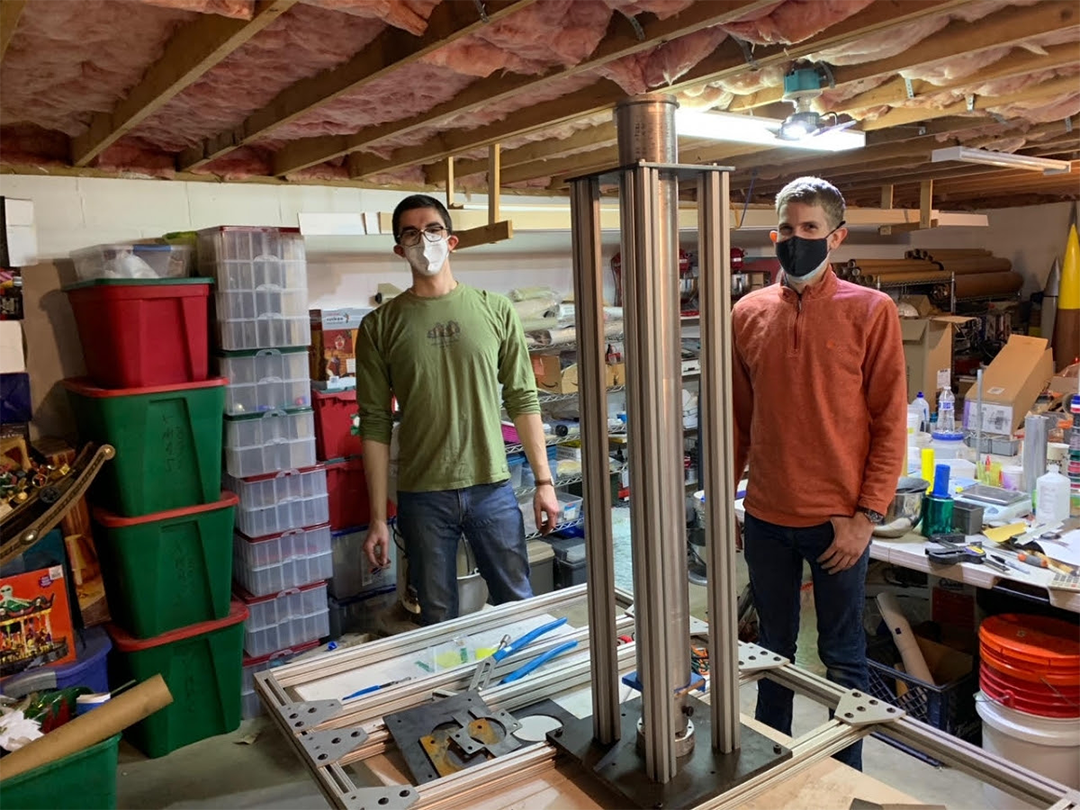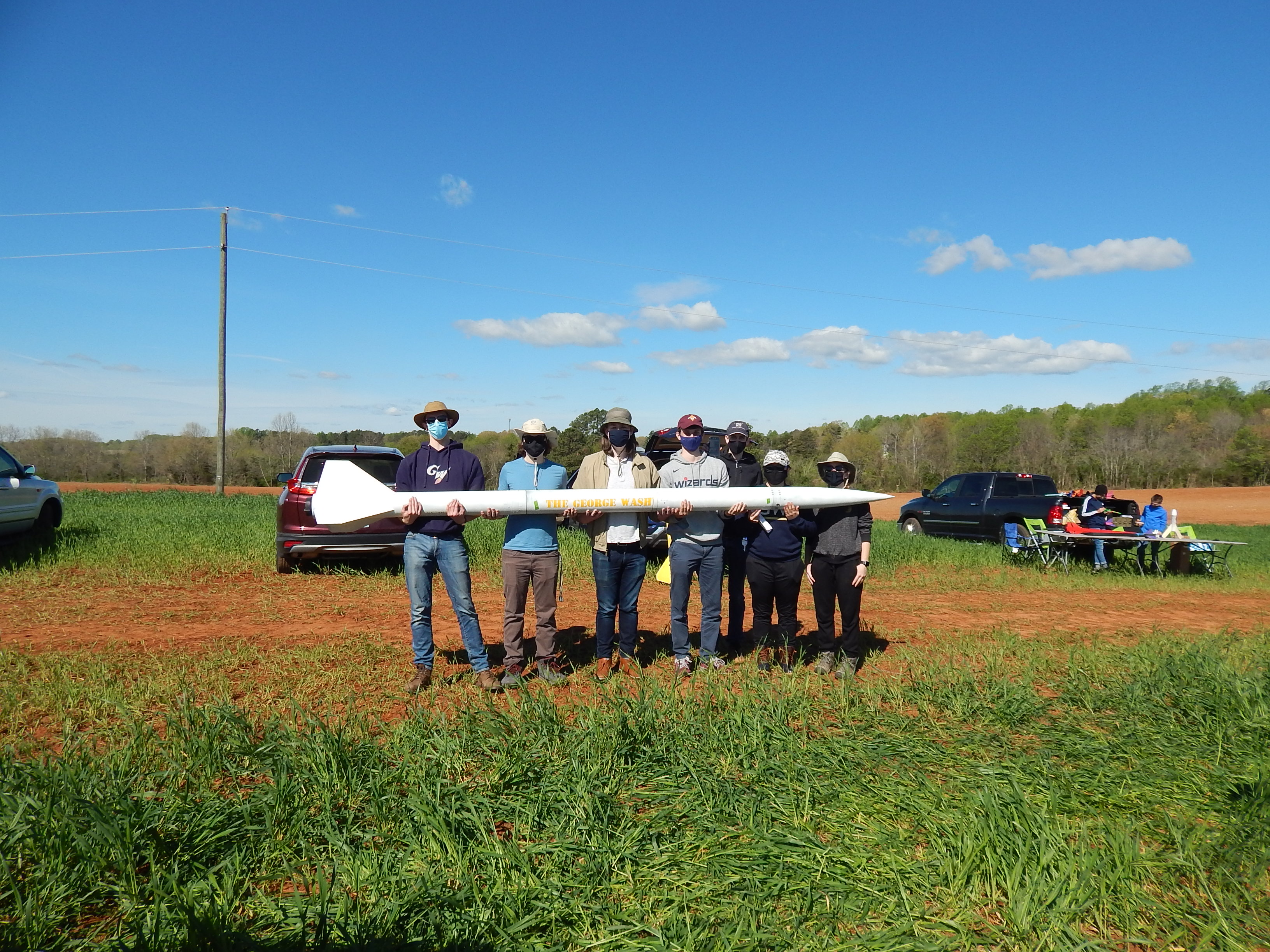By B.L. Wilson
A team of students on the George Washington University Rocket Team working mostly from home because of COVID-19 debated whether they should compete in the virtual 2021 Spaceport America Cup—the largest collegiate rocket competition in the world—and only present the design and calculations for a rocket built with limited campus access.
But faculty adviser Murray Snyder, professor of mechanical and aerospace engineering and international affairs in the School of Engineering and Applied Science, insisted the team launch the rocket.
“I was pretty adamant. ‘No. We will launch [it],’’ he told the students. “I don’t care if it crashes and burns.”
The GW Rocket team built the rocket and launched it with the help of mentors, Ben and Elaine Russell, in a field in Virginia just outside Washington, D.C. They won top prize in the Space Dynamics Lab Payload Competition and received an honorable mention in the 10,000 feet (altitude) Student Research and Development (SRAD) Solid Booster Competition.
The team was led by Ben Wormuth, B.S. ’21, an electrical engineering major, and broken down into four groups that allowed students to specialize in building, launching and recovering the rocket and creating a 10-pound payload system to go into space that tested laser communications between small satellites.
The team’s device is a sort of low-altitude sounding rocket: a sleek composite frame encasing solid rocket boosters of five- to six-inch-long cylinders with propellant that provide enough thrust to lift the rocket to 10,000 feet.
“You take solid rocket boosters obviously on a much smaller scale and you put those in the rocket airframe and you put some parachutes on it and you include space for some kind of experiment (the payload),” said Mr. Wormuth, who had been a member of the team for three and a half years. “One of the ways we stand out in competition is our ability to build reliable motors that perform well year after year.”
William Treaux Jackson, a rising senior and mechanical and aerospace engineering major, led the team that devised the winning payload system. He was assisted by rising senior Mark Yamakaitis and second-year student Phoenix Price in developing software for a laser gimbal and a tracking algorithm for a communications system and a laser receiver that collected the transmitted data.
“It really was an impressive thing they did. This was done by undergraduate students,” said Dr. Snyder. “This is really high-level engineering. It’s really hands on. From my perspective as adviser, it is infinitely better than taking any course that I teach or any exam or homework that I give them because that’s all theoretical.
“Theory is fine, but to get theory to work in practice is really hard.”
In fact, a test launch before the competition of a hybrid, two-stage rocket using a commercial motor experienced a catastrophic failure. It blew up, destroying most of the rocket frame. There were other snafus, allotting the space for parachutes to fit properly and devising a method to release the payload at peak altitude. After each snafu, students retraced their work in the Science and Engineering Hall machine shop. All of this was complicated by team members working in different parts of the country and having to ship their work from on-campus to Kansas and back to Washington, D.C.

Ben Wormuth (l) and Phoenix Price with the test stand, which measures thrust produced by the student-made booster.
Ariana Lesniak, B.S. ’21, led the recovery team, which was in charge of figuring out the size of the parachutes that were we needed to ensure that the rocket descended after launch at a rate slow enough that it didn’t crash and could be reused. She said not being able to physically get their hands on the rocket made her group’s work harder to complete.
“I spent a lot of time on Zoom calls with Ben and the rest of the teams going over recovery stuff,” Ms. Lesniak said. “Ben would put his computer up in the shop so we could look down at the rocket, and I would explain piece by piece what goes where and how this thing comes together and the correct way to do things, and different pieces of hardware.”
The aerostructures group leader was Adam Brewer, B.S. ’21. The team was responsible for building the frame, helping to manage the parachutes and ensuring that the rocket came down safely. He was assisted by rising juniors Eliese Ottinger and Aidan Worthington.
Outgoing team leader Mr. Wormuth, who will be completing work on a master’s degree, was on campus with up and coming juniors Amy Chang and Mr. Price, keeping tabs on the teams, facilitating communication and making sure they had the supplies they needed while building (rebuilding) the rocket motor.
“[Failure] is a really valuable lesson to learn while you’re in school,” he said, “how to deal with an experiment that doesn’t go the way you expected and not only that, pretty much destroys your entire project.”
For Mr. Jackson, who takes over as Rocket team leader his senior year, placing first was a measure of how well the team worked. “It wasn’t just about knowledge being gained but how I could cooperate with others, look outside of myself and help the team get their job done at the end of the day while still contributing what I could to their efforts,” he said.


